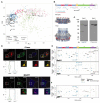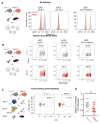Perforin-2 is a pore-forming effector of endocytic escape in cross-presenting dendritic cells
- PMID: 37347855
- PMCID: PMC7614779
- DOI: 10.1126/science.adg8802
Perforin-2 is a pore-forming effector of endocytic escape in cross-presenting dendritic cells
Abstract
During initiation of antiviral and antitumor T cell-mediated immune responses, dendritic cells (DCs) cross-present exogenous antigens on major histocompatibility complex (MHC) class I molecules. Cross-presentation relies on the unusual "leakiness" of endocytic compartments in DCs, whereby internalized proteins escape into the cytosol for proteasome-mediated generation of MHC I-binding peptides. Given that type 1 conventional DCs excel at cross-presentation, we searched for cell type-specific effectors of endocytic escape. We devised an assay suitable for genetic screening and identified a pore-forming protein, perforin-2 (Mpeg1), as a dedicated effector exclusive to cross-presenting cells. Perforin-2 was recruited to antigen-containing compartments, where it underwent maturation, releasing its pore-forming domain. Mpeg1-/- mice failed to efficiently prime CD8+ T cells to cell-associated antigens, revealing an important role for perforin-2 in cytosolic entry of antigens during cross-presentation.
Conflict of interest statement
The authors declare no competing interests.
Figures





References
-
- Palmowski MJ, Gileadi U, Salio M, Gallimore A, Millrain M, James E, Addey C, Scott D, Dyson J, Simpson E, Cerundolo V. Role of Immunoproteasomes in Cross-Presentation. J Immunol. 2006;177:983–990. - PubMed
-
- Kovacsovics-Bankowski M, Rock KL. A Phagosome-to-Cytosol Pathway for Exogenous Antigens Presented on MHC Class I Molecules. Science. 1995;267:243–246. - PubMed
MeSH terms
Substances
Grants and funding
LinkOut - more resources
Full Text Sources
Other Literature Sources
Molecular Biology Databases
Research Materials

